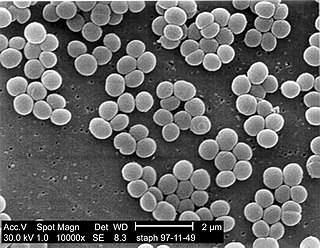
Staphylococcus aureus is a gram-positive spherically shaped bacterium, a member of the Bacillota, and is a usual member of the microbiota of the body, frequently found in the upper respiratory tract and on the skin. It is often positive for catalase and nitrate reduction and is a facultative anaerobe, meaning that it can grow without oxygen. Although S. aureus usually acts as a commensal of the human microbiota, it can also become an opportunistic pathogen, being a common cause of skin infections including abscesses, respiratory infections such as sinusitis, and food poisoning. Pathogenic strains often promote infections by producing virulence factors such as potent protein toxins, and the expression of a cell-surface protein that binds and inactivates antibodies. S. aureus is one of the leading pathogens for deaths associated with antimicrobial resistance and the emergence of antibiotic-resistant strains, such as methicillin-resistant S. aureus (MRSA). The bacterium is a worldwide problem in clinical medicine. Despite much research and development, no vaccine for S. aureus has been approved.

Methicillin-resistant Staphylococcus aureus (MRSA) is a group of gram-positive bacteria that are genetically distinct from other strains of Staphylococcus aureus. MRSA is responsible for several difficult-to-treat infections in humans. It caused more than 100,000 deaths worldwide attributable to antimicrobial resistance in 2019.

Methicillin (USAN), also known as meticillin (INN), is a narrow-spectrum β-lactam antibiotic of the penicillin class.

Mupirocin, sold under the brand name Bactroban among others, is a topical antibiotic useful against superficial skin infections such as impetigo or folliculitis. It may also be used to get rid of methicillin-resistant S. aureus (MRSA) when present in the nose without symptoms. Due to concerns of developing resistance, use for greater than ten days is not recommended. It is used as a cream or ointment applied to the skin.

Vancomycin-resistant Staphylococcus aureus (VRSA) are strains of Staphylococcus aureus that have acquired resistance to the glycopeptide antibiotic vancomycin. Bacteria can acquire resistance genes either by random mutation or through the transfer of DNA from one bacterium to another. Resistance genes interfere with the normal antibiotic function and allow bacteria to grow in the presence of the antibiotic. Resistance in VRSA is conferred by the plasmid-mediated vanA gene and operon. Although VRSA infections are uncommon, VRSA is often resistant to other types of antibiotics and a potential threat to public health because treatment options are limited. VRSA is resistant to many of the standard drugs used to treat S. aureus infections. Furthermore, resistance can be transferred from one bacterium to another.

Pristinamycin (INN), also spelled pristinamycine, is an antibiotic used primarily in the treatment of staphylococcal infections, and to a lesser extent streptococcal infections. It is a streptogramin group antibiotic, similar to virginiamycin, derived from the bacterium Streptomyces pristinaespiralis. It is marketed in Europe by Sanofi-Aventis under the trade name Pyostacine.

Ceragenix Pharmaceuticals, Inc. is a biopharmaceutical company headquartered in Denver, Colorado that develops prescription therapies based on a platform of proprietary surface active technologies—skin Barrier Repair Technology (BRT) and Cerageninis, a new class of broad spectrum anti-infectives. The company discovers, develops and commercializes anti-infective drugs based on its proprietary class of compounds, Ceragenins. Active against a range of gram positive and gram negative bacteria, these agents are being developed as anti-infective medical device coatings and as therapeutics for antibiotic-resistant organisms.

Platensimycin, a metabolite of Streptomyces platensis, is an antibiotic, which acts by blocking the enzymes β-ketoacyl-(acyl-carrier-protein ) synthase I/II (FabF/B).

Oritavancin, sold under the brand name Orbactiv among others, is a semisynthetic glycopeptide antibiotic medication for the treatment of serious Gram-positive bacterial infections. Its chemical structure as a lipoglycopeptide is similar to vancomycin.

Cefoxitin is a second-generation cephamycin antibiotic developed by Merck & Co., Inc. from Cephamycin C in the year following its discovery, 1972. It was synthesized in order to create an antibiotic with a broader spectrum. It is often grouped with the second-generation cephalosporins. Cefoxitin requires a prescription and as of 2010 is sold under the brand name Mefoxin by Bioniche Pharma, LLC. The generic version of cefoxitin is known as cefoxitin sodium.

Dalbavancin, sold under the brand names Dalvance in the US and Xydalba in the EU among others, is a second-generation lipoglycopeptide antibiotic medication. It belongs to the same class as vancomycin, the most widely used and one of the treatments available to people infected with methicillin-resistant Staphylococcus aureus (MRSA).

A staphylococcal infection or staph infection is an infection caused by members of the Staphylococcus genus of bacteria.
mecA is a gene found in bacterial cells which allows them to be resistant to antibiotics such as methicillin, penicillin and other penicillin-like antibiotics.

Nargenicin is a 28 carbon macrolide with a fused tricyclic core that has in addition a unique ether bridge. The polyketide antibiotic was isolated from Nocardia argentinensis. Nargenicin is effective towards gram-positive bacteria and been shown to have strong antibacterial activity against Staphylococcus aureus, including strains that are resistant to methicillin. It has also been shown to induce cell differentiation and inhibit cell proliferation in a human myeloid leukemia cell line.
Linopristin/flopristin is an experimental drug candidate under development by Novexel. It is an oral streptogramin antibiotic that has potent in vitro activity against certain Gram-positive bacteria including methicillin resistant Staphylococcus aureus (MRSA), as well as the important respiratory pathogens including penicillin-, macrolide- and quinolone-resistant strains. It is a combination of linopristin and flopristin.

Sophoraflavanone G is a volatile phytoncide, released into the atmosphere, soil and ground water, by plants of the genus Sophora. Species include Sophora pachycarpa and Sophora exigua, all found to grow within the United States in a variety of soil types, within temperate conditions, no lower than 0 °F. Sophoraflavanone G is released in order to protect the plant against harmful protozoa, bacteria, and fungi. Sophoraflavanone G, also called kushenin, is a flavonoid compound.

Epimerox is an experimental broad-spectrum antibiotic compound being developed by scientists at the Rockefeller University and Astex Pharmaceuticals. It is a small molecule inhibitor compound that blocks the activity of the enzyme UDP-N-acetylglucosamine 2-epimerase, an epimerase enzyme that is called 2-epimerase for short.

Bottromycin is a macrocyclic peptide with antibiotic activity. It was first discovered in 1957 as a natural product isolated from Streptomyces bottropensis. It has been shown to inhibit methicillin-resistant Staphylococcus aureus (MRSA) and vancomycin-resistant Enterococci (VRE) among other Gram-positive bacteria and mycoplasma. Bottromycin is structurally distinct from both vancomycin, a glycopeptide antibiotic, and methicillin, a beta-lactam antibiotic.
Kerry L. LaPlante is an American pharmacist, academic and researcher. She is the Dean at the University of Rhode Island College of Pharmacy. She is a Professor of Pharmacy and former department Chair of the Department of Pharmacy Practice at the University of Rhode Island, an adjunct professor of medicine at Brown University, an Infectious Diseases Pharmacotherapy Specialist, and the Director of the Rhode Island Infectious Diseases Fellowship and Research Programs at the Veterans Affairs Medical Center in Providence, Rhode Island.
MRSA ST398 is a specific strain of Methicillin-resistant Staphylococcus aureus (MRSA). Staphylococcus aureus is a gram-positive, spherical bacterium that can cause a range of infections in humans and animals. And Methicillin-resistant Staphylococcus aureus (MRSA) is a bacterium that is resistant to many antibiotics. The abbreviation "ST" in MRSA ST398 refers to the sequence type of the bacterium. MRSA ST398 is a clonal complex 398 (CC398). This means that the strain had emerged in a human clinic, without any obvious or understandable causes. MRSA ST398, a specific strain of MRSA, is commonly found in livestock, and can cause infections in humans who come into contact with infected animals.


![Figure 2. Formation of the decalin ring by [4+2] cycloaddition. Decalin Formation.tif](http://upload.wikimedia.org/wikipedia/commons/thumb/8/8f/Decalin_Formation.tif/lossless-page1-220px-Decalin_Formation.tif.png)















